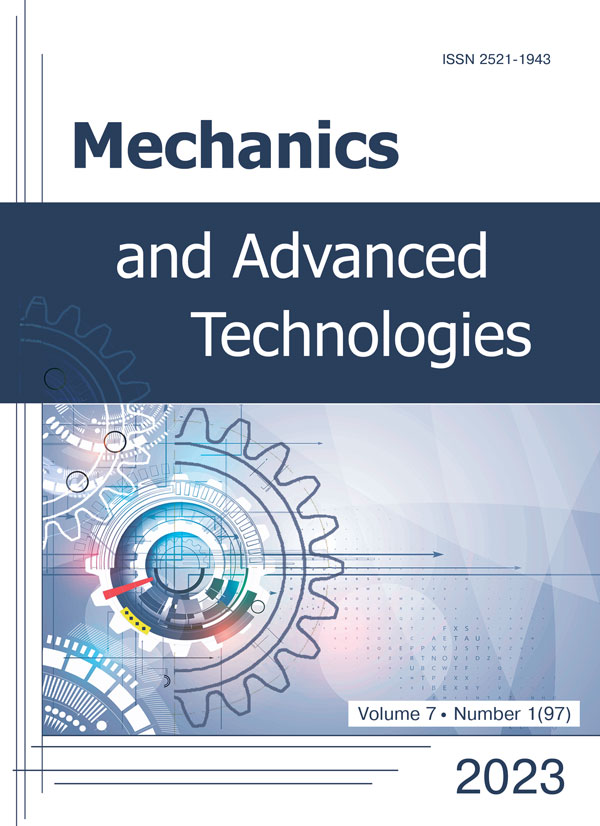Progressive technologies of electrophysical treatment for regulation of stress-strain states of elements of welded structures
DOI:
https://doi.org/10.20535/2521-1943.2023.7.1.277617Keywords:
treatment of welded joints, pulsed magnetic field, pulsed barrier discharge, electrodynamic treatment, aluminium alloy, structural steel, residual displacements, ; stress-strain state, hardness of steelAbstract
The development of industry stimulates the development of modern approaches to the optimization of welded structures. The use of pulsed electromagnetic fields, plasma currents, electrodynamic forces and their combined effects is a new trend in engineering practice to improve the mechanical characteristics of metal materials and welded joints (WJ). Treatment with a pulsed electromagnetic field (TwPEMF) is a promising direction for optimizing the stress-strain states (SSS) of welded structures made of non-ferromagnetic metal materials. Using the method of electronic speckle interferometry, the effect of TwPEMF on the SSS of specimens of circumferential WJ with a thickness of δ = 1.0 mm from aluminium AMg6 alloy was investigated. Based on the original procedure using an accelerometer, the kinetics of the action of the force P of the magnetic field pressure on the residual displacements f and SSS of the specimens during their TwPEMF were investigated. TwPEMF of WJ specimens was performed without and with the use of an additional shield made of AMg6 alloy δ = 5.0 mm. It was found that the use of a shield increases the amplitude values of force P by up to two times, which is caused by an increase in the active volume of the conductive medium. At the same time, TwPEMF without and with the use of a shield contributes to the reduction of f values by 2 and 4 times, respectively, and residual SSS by 50 and 80%. On the basis of mathematical modelling, the advantages of using electrodynamic treatment (EDT) of butt WJ δ = 3.0 mm of АMg61 (1561) alloy in the TIG welding process compared to EDT at room temperature (Tk) are substantiated. According to the results of the model verification, it was proved that EDT during TIG contributes to the formation of peak values of residual compressive stresses in the weld zone by 60% more than EDT during Tk. The use of a pulsed barrier discharge (PBD), which generates a low-temperature plasma on the surface of the metal being treated, contributes to the optimization of its structure. An increase in the hardness HV of structural 25KhGNMT steel as a result of its PBD treatment from 420 to 510 units was established, which is accompanied by the dispersion of the metal microstructure.
References
- L. M. Lobanov, I. P. Kondratenko, A. V. Zhiltsov, N. A. Pashchin and O. L. Mikhodui, “Development of Post-weld Electrodynamic Treatment Using Electric Current Pulses for Control of Stress-Strain States and Improvement of Life of Welded Structures”, Materials Performance and Characterization, vol. 7, no. 4, pp. 941–955, 2018. DOI: https://doi.org/10.1520/MPC20170092.
- V. I. Dubodelov and M. S. Goruk, “The use of electromagnetic fields and magnetodynamic phenomena to intensify the effect on metal systems: world and Ukrainian experience”, in Materials Science: Achievements and Prospects, vol. 2. Кyiv: Akademperiodyka, 2018, pp. 24–50.
- L. M. Lobanov, M. O. Pashchyn, O. L. Mikhodui, Yu. M. Sydorenko and P. R. Ustymenko, “Stress-Strain State of Welded Joints of AMg6 Alloy after Electrodynamic Treatment During Welding”, Strength of Materials, vol. 54, no. 6, pp. 983–996, 2022. DOI: https://doi.org/10.1007/s11223-023-00474-y.
- L. M. Lobanov, M. O. Pashchyn, O. L. Mikhodui, O. V. Cherkashyn, T. G. Solomiichuk, P. S. Shl’ons’kyi and I. P. Kondratenko, “Pulsed Electromagnetic Field Effect on Residual Stresses and Strains of Welded Joints of AMg6 Aluminum Alloy”, Strength of Materials, vol. 53, no. 6, pp. 834–841, 2021. DOI: https://doi.org/10.1007/s11223-022-00350-1.
- L. М. Lobanov, М. О. Pashchin, О. L. Mikhodui, О. V. Cherkashyn and І. P. Kondratenko, “Influence of Pulsed Electromagnetic Field Treatment on the Stressed State of AMg6 Aluminum Alloy”, Materials Science, vol. 57, no. 1, pp. 1–8, 2021. DOI: https://doi.org/10.1007/s11003-021-00507-4.
- I. V. Bozhko, I. P. Kondratenko, L. M. Lobanov, М. О. Pashchin, O. M. Berdnikova, O. L. Mykhodui, O. S. Kushnarova and P. V. Goncharov, “Pulsed barrier discharge for treatment of surfaces of 25ХГНМТ steel plates”, Tekhnichna Elektrodynamika, no. 1, pp. 76–80, 2023. DOI: https://doi.org/10.15407/techned2023.01.076.
- Kistler Instrumente AG. Quartz Accelerometer 8042. Available: https://www.datasheetarchive.com/kistler-datasheet.html.
- L. M. Lobanov, M. O. Pashchyn, O. L. Mikhodui, P. V. Goncharov, Yu. M. Sydorenko and P. R. Ustymenko, “Modeling of stress-strain states of AMg6 alloy due to impact action of electrode-indenter in electrodynamic treatment”, The Paton Welding J., no. 6, pp. 2–11, 2021. DOI: https://doi.org/10.37434/tpwj2021.06.01.
Downloads
Published
How to Cite
Issue
Section
License
Copyright (c) 2023 Леонід Лобанов, Павло Устименко, Юрій Сидоренко, Микола Пащин

This work is licensed under a Creative Commons Attribution 4.0 International License.
Authors who publish with this journal agree to the following terms:
- Authors retain copyright and grant the journal right of first publication with the work simultaneously licensed under CC BY 4.0 that allows others to share the work with an acknowledgement of the work's authorship and initial publication in this journal.
- Authors are able to enter into separate, additional contractual arrangements for the non-exclusive distribution of the journal's published version of the work (e.g., post it to an institutional repository or publish it in a book), with an acknowledgement of its initial publication in this journal.
- Authors are permitted and encouraged to post their work online (e.g., in institutional repositories or on their website) prior to and during the submission process, as it can lead to productive exchanges, as well as earlier and greater citation of published work











